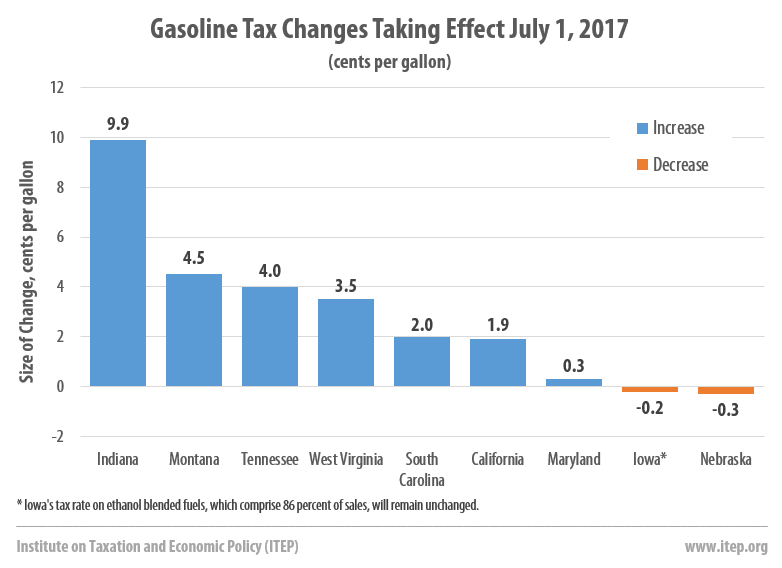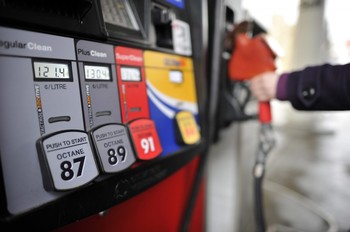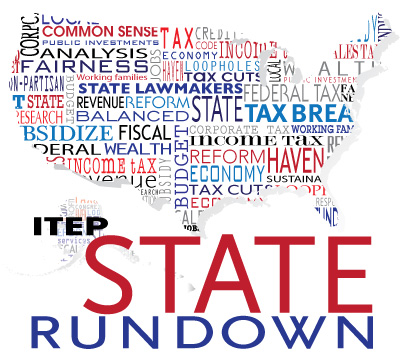Summer gas prices are at their lowest level in twelve years, which makes right now a sensible time to ask drivers to pay a little more toward improving the transportation infrastructure they use every day. Seven states will be doing this on Saturday, July 1 when they raise their gasoline tax rates. At the same time, two states will be implementing small gas tax rate cuts.
Here are the details on the changes taking place in each state:
Indiana is raising its gasoline tax rate by 9.9 cents and its diesel tax rate by 10 cents due to legislation enacted earlier this year. (While Indiana’s excise tax rate on gasoline will rise by an even 10 cents, a separate 0.1 cent cut will also take effect because a portion of the state’s tax rate is tied to the monthly price of gas.) This marks the state’s first gas tax increase since January 2003. Looking ahead, Indiana’s fuel tax rates will be adjusted between 2018 and 2024 based on a new formula that considers both inflation and the rate of growth in Indiana’s total personal income (more information on these types of formulas is available in our updated policy brief.
Montana is increasing its gasoline tax by 4.5 cents and its diesel tax by 1.5 cents under legislation enacted this year. This is the first stage of a slightly larger increase that will eventually raise the gas tax by 6 cents and the diesel tax by 2 cents in total. This is Montana’s first gas tax increase in 23 years.
Tennessee is boosting its gasoline and diesel tax rates by 4 cents each on Saturday under legislation enacted this year at the urging of Gov. Bill Haslam. This is the first stage of a 3-part increase. By July 2019, the state’s gas tax will have risen by 6 cents, and its diesel tax by 10 cents. This Saturday’s increase marks the first adjustment in Tennessee’s gas tax rate in over a quarter century, going back to July 1, 1989.
West Virginia is raising its gasoline and diesel tax rates by 3.5 cents as a result of legislation championed by Gov. Jim Justice. Because West Virginia’s fuel tax rates are tied to the price of gas, they have fallen since 2014 and have become stuck at their minimum “floor” amount. The new law increases that floor.
South Carolina is increasing its gasoline and diesel tax rates by 2 cents each as a result of legislation enacted this year over the veto of Gov. Henry McMaster. This is the first stage of a 6-year increase that will raise South Carolina’s fuel tax rates by 12 cents per gallon. South Carolina has one of the lowest and most outdated gas tax rates in the country, having last been updated on Jan. 1, 1989.
California is boosting its gas tax rate by 1.9 cents because of a formula that ties the rate to the price of gas. The state’s diesel tax rate will not change on July 1. More significant, however, will be the 12-cent gas tax increase and 20-cent diesel tax increase that will take effect on Nov. 1, 2017 because of legislation enacted this year.
Maryland is raising its gasoline and diesel tax rates by a modest 0.3 cents each because of a forward-thinking inflation indexing law that former Gov. Martin O’Malley signed in 2013.
Iowa is cutting its gasoline tax rate by 0.2 cents and leaving its diesel tax rate unchanged. Most drivers are unlikely to be affected by this cut, however, as 86 percent of fuel sold in Iowa is ethanol blended and the tax rate on ethanol blends will remain unchanged.
Nebraska is cutting its gasoline and diesel tax rates by 0.3 cents per gallon because of a law tying the state’s tax rate to the price of fuel. This follows a 1.5 cent increase that was implemented on Jan. 1 under legislation enacted in 2015, and will likely be negated in six months by an additional 1.5 cent increase scheduled to take effect under that same law.
New Jersey is increasing its diesel tax rate by 10.8 cents on July 1, though its tax rate on gasoline will remain unchanged. This is the final stage in a series of increases scheduled under legislation enacted in 2016.
While most of the states discussed above are moving forward with gas tax updates, many others continue to lag far behind. Our updated policy brief counts 19 states that have waited a decade or more since last increasing their gas tax rates. Some of those states, such as Alaska, Louisiana, and Oklahoma, seriously considered gas tax increases this year, but the political obstacles proved too daunting. Expect the gas tax debates in those states, and others, to continue in the near future.
See chart of July 1 gasoline tax rate changes
See chart of July 1 diesel tax rate changes
See updated policy brief: How Long Has it Been Since Your State Raised Its Gas Tax?
See updated policy brief: Most Americans Live in States with Variable-Rate Gas Taxes





